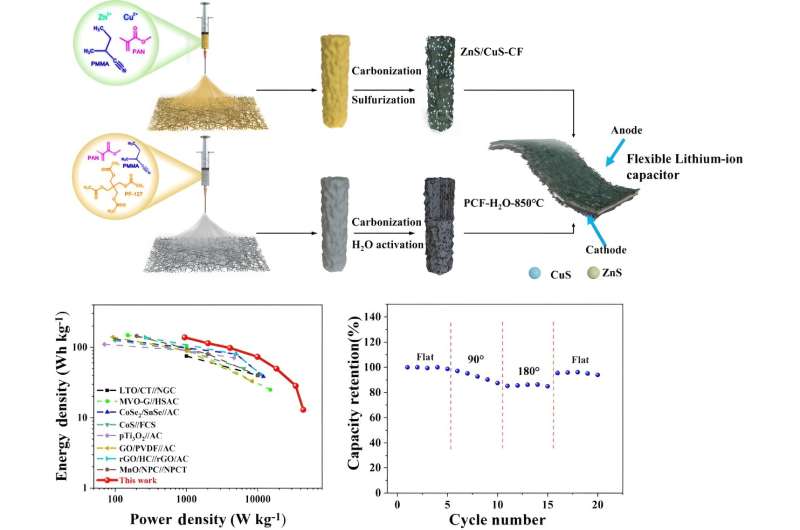
The use of dual metal sulfides, specifically ZnS/CuS, shows marked improvement in electrochemical stability and performance when included in the design of flexible lithium-ion capacitors over the use of transition metal sulfides and carbon fiber materials.
Technology is becoming more and more integrated with daily life, especially wearable, flexible tech and smart devices. Transition metal sulfide (TMS) materials are popular among choices for anodes in developing flexible lithium-ion capacitors (FLICs), but do not live up to their theoretical capabilities when put into practice. Researchers looking to change that have developed zinc-sulfide nanoparticles that can be embedded in multichannel carbon fibers (CFs) to enhance the performance of FLICs.
The results were published in Energy Materials and Devices on December 13.
The researchers went about navigating the challenges of traditional powder electrodes by utilizing a solution blow spinning method, a method that produces fiber sheets with a high porosity and large surface area. This was followed by sulfidation, which adds sulfide ions to the material.
The resulting material is multichannel carbon fibers with embedded ZnS/CuS nanoparticles. This material showed lower resistance to charge transfer and ion diffusion, as well as improved high specific capacity and rate capacity. By combining mixed metal sulfides with a FLIC, energy and power densities were improved.
"An effective strategy to enhance the energy and power densities of CF-based anode materials involves coupling them with highly active materials," said Bohan Li, researcher and author of the study.
Metals like zinc, when combined with sulfides, appear to have a good track record in conjunction with carbon fibers to yield a high-capacity anode. Their high activity level can make for a faster reaction, which is a significant area of improvement in FLICs.
In addition to the material's improved performance, the structure of the carbon fiber network reduces the chance of the nanoparticles bunching up, which helps maintain consistency in cycling and stability.
"Carbon fibers function as a conductive network and 3D matrix, accommodating volume expansion and maximizing the high-capacity feature of ZnS and CuS nanoparticles. This enhances the specific capacity and cycle stability of CF-based anode materials," said Li.
The carbon fibers' three-dimensional matrix also reduces how much the ZnS and CuS can expand. Expansion of the components inside the battery can—at the very least—reduce function, but at worst, cause a complete failure of the battery.
When it came to testing how usable the tech would be under pressure (bending), a pouch cell was used. Pouch cells essentially are an enclosed anode and cathode with a separator and conducting material; these are often used in cars, laptops or cell phones. The results show how flexible the technology is with various angles of bend being used to light up an LED, which was successful at all angles. Not only did the tech hold up to bending initially, but it returned to its original shape with no issue, an integral part of the function of flexible technology.
The goal of this material is to improve upon existing technology to improve the variety of smart, flexible devices that are flooding into the mainstream. Improvements in these types of electronics can lead to more sustainable tech that is widely available for consumers and companies to take advantage of. Production of the ZnS/CuS nanoparticles on a continuous carbon fiber network would need to be scaled up to be a technology available for use in portable and wearable devices over the typical TMSs used in FLICs.
Bohan Li, Chong Wang, Zhouyang Qin, Changzhen Zhan, Liangliang Li, Wanci Shen and Zheng-Hong Huang of the Key Laboratory of Advanced Materials at Tsinghua University with Ruitao Lv and Zheng-Hong Huang also of the State Key Laboratory of New Ceramics and Fine Processing at Tsinghua University, and Chenhui Luan of the School of Chemical and Environmental Engineering at China University of Mining and Technology contributed to this research.
More information: Bohan Li et al, ZnS/CuS nanoparticles encapsulated in multichannel carbon fibers as high-performance anode materials for flexible Li-ion capacitors, Energy Materials and Devices (2023). DOI: 10.26599/EMD.2023.9370012
Provided by Tsinghua University Press
Citation: Dual-metal sulfides found to improve overall function of anode material in lithium-ion capacitors (2024, January 16) retrieved 16 January 2024 from https://techxplore.com/news/2024-01-dual-metal-sulfides-function-anode.html
This document is subject to copyright. Apart from any fair dealing for the purpose of private study or research, no part may be reproduced without the written permission. The content is provided for information purposes only.
